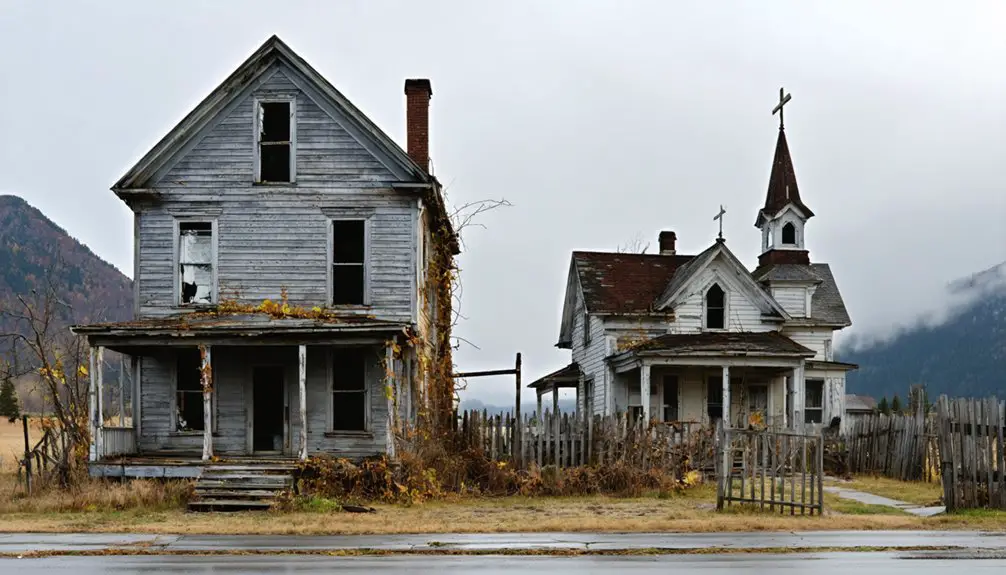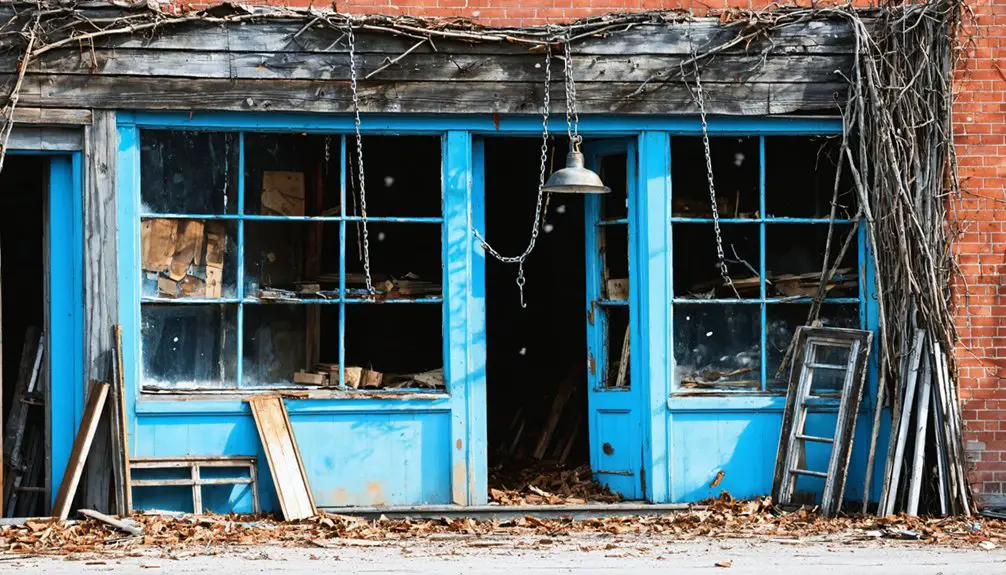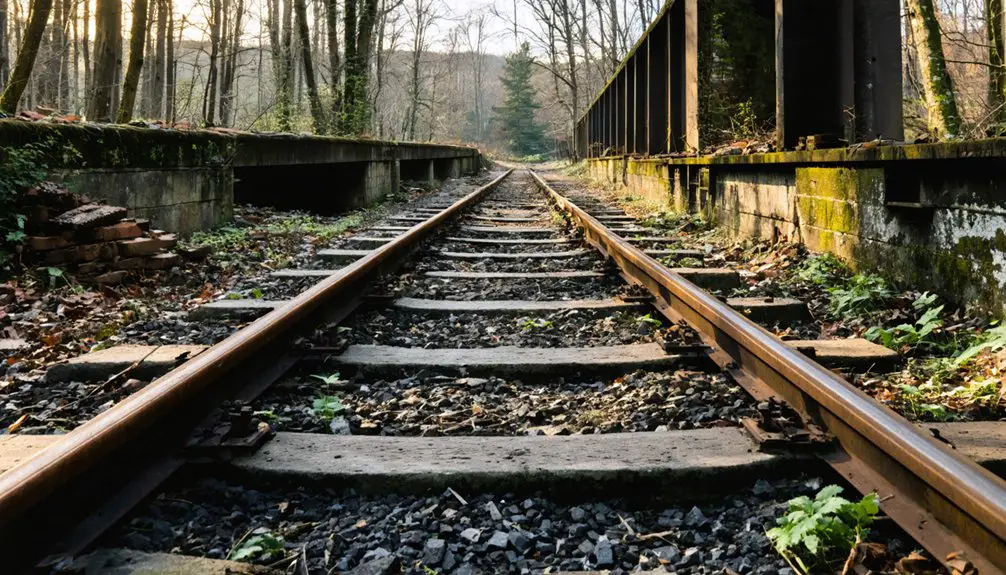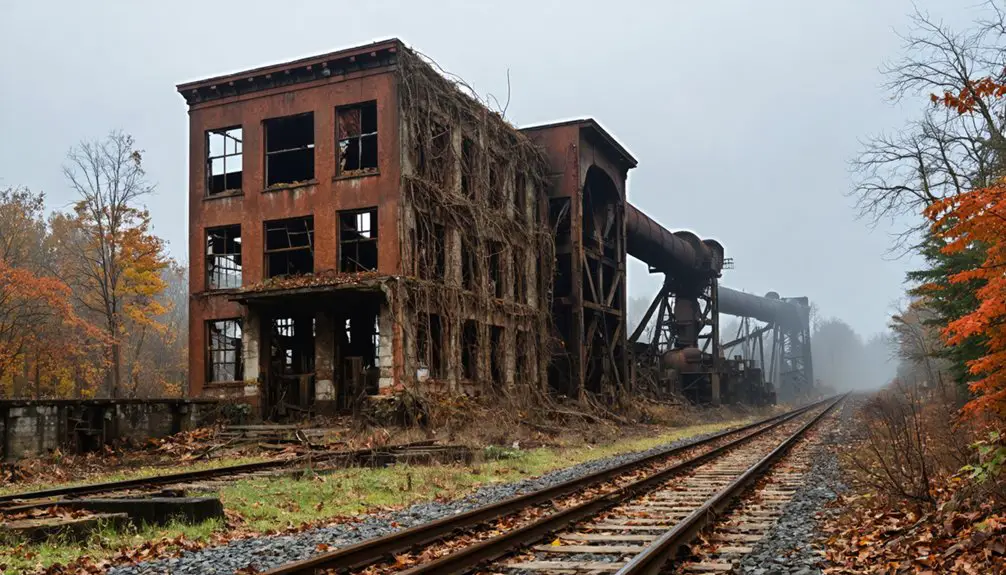You’ll find Ferrier’s haunting remains in Cambria County, Pennsylvania, where this once-thriving coal mining town peaked at 2,700 residents in the late 1800s. Irish Catholic immigrants built a close-knit community around the mine shafts, with local shops, taverns, and churches serving as cultural hubs. The sudden mine closures in 1962 forced an exodus, leaving hundreds jobless overnight. The town’s silent ruins now tell a compelling story of Pennsylvania’s industrial transformation.
Key Takeaways
- Ferrier was a thriving coal mining town in Pennsylvania that reached its peak population of 2,700 residents in the late 1800s.
- The community was predominantly Irish Catholic and developed around mining operations with shops, taverns, and churches serving as social centers.
- The town’s prosperity relied heavily on coal transportation networks, including the Mine Run Railroad and Lehigh Valley Railroad branch.
- Sudden mine closures in 1962 led to widespread unemployment, forcing residents to abandon their homes and businesses.
- Environmental hazards from underground mining and the eventual decline of the coal industry turned Ferrier into an uninhabited ghost town.
The Birth of a Mining Settlement
Three key factors converged to birth the mining settlement of Ferrier in western Pennsylvania during the early to mid-19th century.
You’ll find the first was the discovery of premium bituminous coal – the kind that burned clean without sulfur or ash, making it perfect for iron production.
Next came the English miners who introduced advanced mining techniques, transforming the simple drift mines into sophisticated shaft operations. Similar to how Philip Ginter discovered anthracite coal that transformed mining in eastern Pennsylvania, these innovations revolutionized the industry.
Finally, the strategic location near transport routes sealed Ferrier’s destiny. The narrow gauge railroads connected the mines directly to the Beaver and Lake Erie Canal.
As you explore the settlement’s origins, you’ll see how these elements shaped the community dynamics.
Workers’ homes clustered around mine shafts, while the company store and other services sprang up to support the growing population.
It’s a classic tale of how Pennsylvania’s rich mineral resources turned wilderness into thriving industrial communities.
Life in Ferrier’s Peak Years
During its peak years in the late 1800s, Ferrier bustled with nearly 2,700 residents, their lives intertwined through the shared rhythms of coal mining and community gatherings.
Nineteenth-century Ferrier thrived as a close-knit mining town, where 2,700 souls found unity through labor and fellowship.
You’d find diverse immigrant contributions shaping the town’s character, as families from various backgrounds built a tight-knit community centered around the mines, churches, and the historic Bull’s Head Tavern. The Irish Catholic immigrants quickly became the predominant group, bringing their strong religious and cultural traditions to the area.
Similar to anthracite coal deposits that once sustained Centralia, mining operations drove Ferrier’s economy and employment.
- Streets planned by engineer Alexander Rae gave the town its organized structure.
- The Mine Run Railroad connected residents to commerce and opportunities beyond.
- Local shops and taverns served as vibrant social hubs where stories were shared.
- Churches doubled as cultural centers, strengthening generational bonds.
- Families often supplemented mining income through small-scale farming and trade.
Despite the challenges of cramped living conditions and mining hazards, residents forged lasting connections through shared experiences and working-class traditions.
Mining Operations and Economic Growth
While small-scale mining operations dotted Ferrier’s early landscape, the arrival of major companies like Cambria Iron Company transformed the town into a significant coal production hub by the late 1800s.
You’d find miners working grueling shifts using room-and-pillar techniques, hauling coal carts through dark tunnels despite constant dangers from cave-ins and methane gas. The room-and-pillar method remained the primary technique for extracting coal throughout Pennsylvania’s mining history.
By 1901, 130 significant mines were operating throughout Cambria County, marking the industry’s peak expansion era.
As mining machinery advancements improved efficiency, companies like Heisley & Coleman expanded their reach through subsidiaries and railroad networks.
The Cambria & Indiana Railroad’s shortline became essential for transporting coal to hungry steel mills.
Though labor union movements fought for better conditions, miners endured hazardous work out of necessity.
The industry’s growth attracted waves of workers to Ferrier, spawning new businesses and transforming it into a bustling mining town.
Railroad Connection and Transportation
If you’d visited Ferrier in the mid-1800s, you’d have witnessed the Mine Run Railroad’s arrival in 1854, which transformed the region into a bustling transportation hub for coal mining operations.
The addition of the Lehigh Valley Railroad’s branch line in 1865 further expanded both passenger and freight capabilities, connecting Ferrier and neighboring Centralia to broader markets. The railroad’s success was largely due to transporting anthracite coal, which burned hotter and cleaner than other coal varieties.
These rail networks, complete with stations and freight yards, served as lifelines for the community until the decline of anthracite mining in the mid-20th century led to their eventual abandonment. Like the New York Ontario Western Railway’s complete liquidation in 1957, the rail infrastructure around Ferrier was quickly dismantled or left to decay.
Railroad Station Operations
As passengers navigated through the Pennsylvania Railroad‘s Exchange Place station in Jersey City before 1910, they’d experience a seamless transfer between trains and ferries without exposure to the elements.
This transportation innovation marked a significant phase in railroad expansion, showcasing the PRR’s commitment to passenger comfort and operational efficiency. The station’s renovations between 1888 and 1892 dramatically improved the indoor transfer system for travelers.
You’ll find these remarkable features that defined Exchange Place’s operations:
- Direct access between trains and ferries through covered walkways
- Multiple ferry routes connecting to Manhattan and Brooklyn
- Twenty-minute crossing times during favorable weather conditions
- Connections to various Manhattan locations including Cortlandt Street
- Strategic integration with PRR’s northern corridor from Newark
The station’s design prioritized your freedom of movement, making it an essential hub in the Northeast’s transportation network until its closure in 1961, when suburban rail decline and financial challenges forced its shutdown.
The terminal’s history traces back to 1812 when the first steam ferry service launched from Paulus Hook, establishing a crucial transportation link that would later evolve into the Exchange Place complex.
Transportation Infrastructure Development
Transportation networks shaped the destiny of Pennsylvania’s coal towns, and Centralia’s story began with the Reading Road of 1770. This essential transportation route, connecting Reading to Fort Augusta, laid the groundwork for the region’s future development and eventually became Route 61.
You’ll find that the town’s economic connections truly expanded with the arrival of the Mine Run Railroad in 1854. This critical line transformed Centralia into a bustling coal transportation hub, running east of town along what’s now Big Mine Run Road.
When the Lehigh Valley Railroad added its branch in 1865, you could see Centralia’s importance grow even further, as it established both freight and passenger services. These rail connections weren’t just about moving coal – they brought in mining equipment, workers, and new opportunities for economic growth.
Social Structure and Community Life

During its peak years, Ferrier thrived as a close-knit mining community of roughly 1,200 residents, where multi-generational families forged deep social bonds through shared work and daily life.
The community dynamics revolved around the coal mining industry, with social interactions centered on local institutions and gathering places.
- The American Legion served as a crucial hub for veterans and community organizing
- Churches and schools anchored cultural life and social connections
- Local shops and businesses sustained a self-sufficient small-town economy
- Union activities fostered strong worker solidarity and collective identity
- Community gatherings and centennial celebrations reinforced local pride
The town’s social fabric ultimately unraveled when environmental hazards forced most residents to relocate, though the spirit of Ferrier lives on through preservation efforts and historical commemoration.
The Decline of Mining Activities
While Ferrier’s coal mining industry initially flourished through the mid-20th century, the introduction of mechanized operations marked the beginning of its decline.
You’d have witnessed fewer miners walking the streets as new machinery replaced manual labor, dramatically reducing the workforce needed to extract coal.
The economic shifts of the late 1970s dealt another devastating blow to Ferrier’s mining operations.
As steel industry demand plummeted and foreign competition intensified, the town’s mining companies struggled to maintain profitability.
The mechanization impacts were particularly harsh in Ferrier’s deep underground mines, where expensive equipment costs combined with stricter environmental regulations made operations increasingly unsustainable.
Abandonment and Exodus

If you’d visited Ferrier in the early 1960s, you’d have found a bustling mining community where generations of families depended on coal for their livelihood.
The sudden closure of the mines left hundreds jobless overnight, triggering a mass exodus that transformed once-lively streets into silent reminders of the town’s mining heritage.
Mining Jobs Disappear Overnight
As underground fires consumed the coal seams beneath Ferrier in 1962, hundreds of miners faced sudden unemployment when safety hazards forced the mines to close overnight.
Despite community resilience and attempts at job retraining programs, the economic impact proved devastating as toxic gases and ground instability made the area uninhabitable.
The sudden loss of mining jobs triggered a cascading effect:
- Businesses dependent on miners’ wages quickly shuttered
- Property values plummeted as families fled
- Tax revenue dried up, crippling public services
- Equipment suppliers and transport companies went bankrupt
- Local shops and schools closed as the population dwindled
You’d have witnessed the rapid transformation of a once-thriving mining town into a ghost town, as the underground inferno not only destroyed jobs but also the very foundation of the community’s existence.
Population Flees Mining Town
Once the underground coal fire began spewing toxic fumes in 1962, Ferrier’s population faced an impossible choice: abandon their homes or risk their lives.
You’d have seen the town’s strong community identity crumble as families gradually packed up and left, their exodus accelerating dramatically in the 1980s when government buyout programs offered an escape route.
The town’s economic resilience couldn’t withstand the double blow of vanishing mining jobs and uninhabitable conditions.
From a thriving population of 1,200, you’d now find just a handful of holdouts remaining.
As schools closed and churches shuttered, social bonds that had defined generations unraveled.
Former residents scattered across neighboring towns, carrying with them only memories of their once-proud mining community, now reduced to a toxic wasteland.
Empty Streets Tell Story
Today, walking through Ferrier’s abandoned streets feels like stepping into a post-apocalyptic scene. Ghostly echoes of the past linger in every crumbling building and buckled road, where nature’s slow reclamation tells the story of sudden exodus.
You’ll find forgotten memories scattered among empty storefronts and homes, their broken windows staring blankly at overgrown lots.
- Steam rises eerily from ground vents, marking the unstoppable underground inferno
- Rerouted highways and condemned buildings stand as silent witnesses to mass departure
- Graffiti art on abandoned routes speaks of defiant human expression amid decay
- Mining equipment rusts quietly, monuments to an industrial heritage cut short
- A handful of stubborn residents remain, keeping watch over their dying town
Physical Remains Today

The physical remains of Ferrier stand as stark reminders of its coal-mining past and ongoing underground inferno. As you explore these ruins, you’ll find few intact structures – most buildings have crumbled or been demolished, leaving only scattered foundations and partial walls to mark their existence.
The environmental hazards are immediately apparent: metal venting pipes pierce the landscape, releasing underground smoke and gases from the burning coal seam below.
You’ll notice the town’s infrastructure bears witness to nature’s destructive force. The original Route 61 succumbed to ground subsidence, forcing its rerouting in the 1990s.
Throughout the area, you’ll encounter buckled roads, cracked sidewalks, and ground fissures that continue to emit smoke. Scorch marks and fire damage scar the surviving structures, while the surrounding terrain remains eerily barren.
Legacy in Pennsylvania’s Mining History
When you examine Ferrier’s evolution from a bustling mining settlement to a ghost town, you’ll find a microcosm of Pennsylvania’s broader coal industry transformation.
The town’s connection to the Cambria Iron Company, which produced over 22 million tons of coal by 1931, exemplifies how these settlements powered America’s industrial revolution through both bituminous mining operations and immigrant labor.
You can trace Ferrier’s particular significance through its room-and-pillar mining innovations and the Cambria & Indiana Railroad infrastructure, which established lasting patterns of industrial development still visible in western Pennsylvania’s landscape.
Mining Settlement Evolution
During Pennsylvania’s transformative mining era of the 1830s, drift mining emerged as the first method of extracting coal from hillsides, setting in motion a technological evolution that would reshape the state’s industrial landscape.
Settlement patterns followed the discovery of rich mineral deposits, with mining technologies advancing from simple surface extraction to sophisticated shaft mining by the 1850s.
- Mining villages like New Virginia and Bethel sprung up around productive coal seams
- Narrow gauge railroads connected remote mines to major waterways
- Communities developed unique identities tied to their mining heritage
- Settlement growth directly correlated with mining production peaks
- The integration of rail networks sparked economic expansion
You’ll find that these mining settlements weren’t just workplace clusters – they were vibrant communities that adapted and evolved with each technological breakthrough, forever changing Pennsylvania’s industrial and social fabric.
Historical Industry Impact
As Pennsylvania’s mining history unfolded, Centralia’s tragic legacy emerged as a watershed moment that forever changed the industry’s landscape.
You’ll find that this disaster challenged assumptions about economic resilience in mining towns, as the underground fire forced an entire community to abandon their homes and livelihoods. The impact rippled through Pennsylvania’s anthracite region, prompting significant reforms in mine safety regulations and waste management practices.
The collapse of Centralia’s community identity serves as a sobering reminder of mining’s hidden dangers.
What you’re seeing in its aftermath is a complete transformation of how both public and private sectors approach abandoned mine management. The town’s story continues to influence policy decisions, making officials more vigilant about potential environmental hazards in former mining sites across the state.
Preservation and Historical Records
Though Ferrier’s physical remnants have largely vanished, extensive historical documentation preserves the town’s legacy through land records, government studies, and media coverage.
You’ll find preservation challenges similar to nearby Centralia, where historical records paint a vivid picture of Pennsylvania’s industrial heritage despite physical deterioration.
- Original land transactions from 1749 detail Native American agreements
- Revolutionary War hero Robert Morris’s 1793 acquisition marks key ownership changes
- Engineering studies map underground fire spread across 3,700 acres
- Federal relocation programs document community displacement
- Media coverage and documentaries capture the town’s transformation
The federal government’s involvement in preserving what remains has created a delicate balance between protecting heritage and maintaining public safety.
While buildings may crumble, the detailed archival records guarantee Ferrier’s story won’t be forgotten.
Frequently Asked Questions
Are There Any Reported Paranormal Activities or Ghost Sightings in Ferrier?
You won’t find documented ghost encounters or supernatural phenomena in this location. Unlike nearby Centralia’s famous hauntings, there’s no concrete evidence or widespread reports of paranormal activity you can verify here.
Can Visitors Legally Explore the Remnants of Ferrier Today?
You can’t legally explore Ferrier without permission since it’s private property. There aren’t any official visitor guidelines or exploration regulations – entering would constitute trespassing and could result in legal consequences.
What Happened to the Original Town Records and Documents?
A mountain of missing archives was scattered when residents fled the mine fire. You won’t find most original records – they were lost or destroyed during evacuation, with minimal historical preservation efforts.
Were There Any Major Accidents or Disasters During Ferrier’s Mining Years?
While mining accidents likely occurred, you won’t find records of major disasters specific to Ferrier’s mines. The area’s mining operations shared typical Pennsylvania coal mining risks, but no catastrophic events are documented.
Did Any Famous or Notable People Ever Live in Ferrier?
Like shadows lost to time, you won’t find any notable residents or historical figures who called Ferrier home. Records show only hardworking coal miners and their families lived in this forgotten town.
References
- https://www.onlyinyourstate.com/experiences/pennsylvania/abandoned-eerie-place-pa
- https://www.youtube.com/watch?v=BlioLNgiKCk
- https://www.youtube.com/watch?v=Qj5LjacccJ0
- https://www.youtube.com/watch?v=TRPq8UmpjsQ
- https://www.roadunraveled.com/blog/centralia-modern-day-ghost-town/
- https://www.hermitage.net/367/Early-Settlers
- https://pittsburghgeologicalsociety.org/uploads/pubs/2018_PGS_Fieldtrip_Guidebook_Fayette_Co_Iron.pdf
- https://palaborhistorysociety.org/timeline-of-labor-history-in-pennsylvania/
- https://www.pa.gov/agencies/dep/programs-and-services/mining/bureau-of-mining-programs/pa-mining-history.html
- https://www.iup.edu/library/departments/archives/coal/coal-culture-timeline.html



